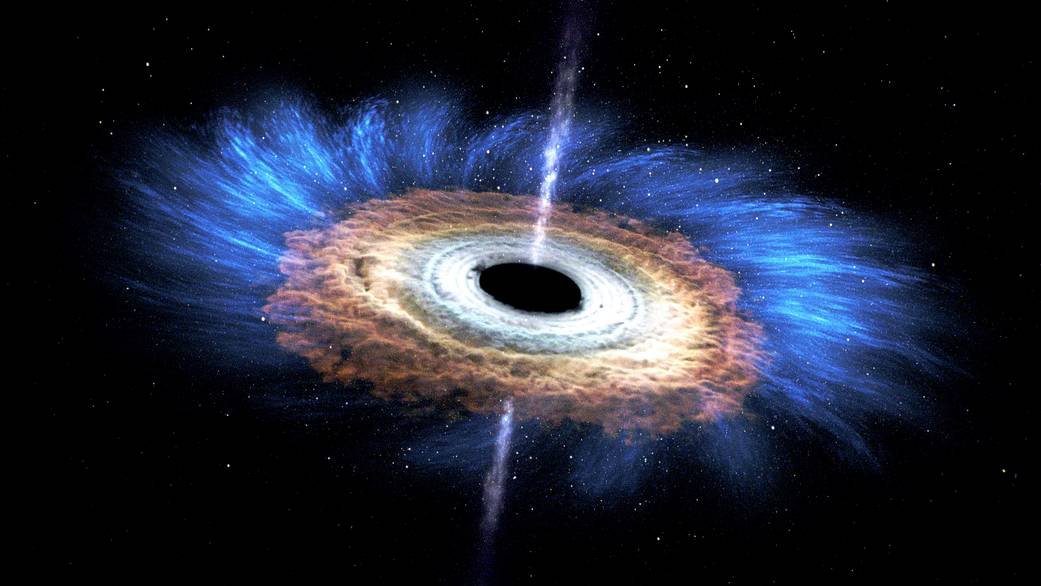Senior Matt Cufari One of Two National Winners of the American Physical Society’s LeRoy Apker Award for Work Related to Black Holes
The award celebrates outstanding physics achievement among undergraduate students.

Just as the saying cautions us, “don’t fly too close to the sun,” the same holds true for stars orbiting black holes millions of light-years away. When a star wanders too close to a black hole in the center of a galaxy, the immense gravity of the black hole shreds the star apart, transforming it into a stream of debris. That debris then rains back down onto the black hole and forms a very hot, very bright disk of material swirling around the black hole, known as an accretion disc, which illuminates the black hole to cosmological distances.
Syracuse University senior Matt Cufari has been studying this phenomenon, known as a Tidal Disruption Event (TDE), with his advisor Eric Coughlin, assistant professor of physics in the College of Arts and Sciences (A&S). Along with Chris Nixon, associate professor of theoretical astrophysics at the University of Leicester (UK), the team is using numerical simulations to verify how a star comes to be on a particular orbit around a black hole, offering important insight about the behavior of the cosmos.
Cufari, who is a physics major in A&S and computer science major in the College of Engineering and Computer Science, has received the American Physical Society’s LeRoy Apker Award for his work on that project. Presented to only two students in the United States each year (one to a Ph.D. granting institution and one to a non-Ph.D. granting institution), the highly selective Apker award recognizes outstanding achievements in physics by undergraduate students and provides encouragement to students who have demonstrated great potential for future scientific accomplishment. For winning the award, Cufari receives $5,000, with another $5,000 going to the physics department to enrich undergraduate research. It is the latest in a series of prestigious honors for Cufari, who is a Coronat Scholar, 2022-23 Astronaut Scholar, 2022 Goldwater Scholar and a member of the Renée Crown University Honors Program.

As part of the award, Cufari will travel to an upcoming American Physical Society meeting to present a talk about a model that he, Coughlin and Nixon devised, which formulates a mechanism for placing a star on a tightly bound orbit about a black hole.
The group’s work appeared in the Astrophysical Journal Letters. Using numerical simulations, they were able to confirm and reproduce predictions about “periodic nuclear transients” - repeating flares in the centers of galaxies created by the remnants of a star orbiting a black hole. They explored a specific situation where a binary star system (two stars that orbit one another under their mutual gravitational attraction) passes so close to a black hole that the binary is destroyed, with one member of the binary ejected from the galaxy and the other captured and placed onto an orbit about the black hole. In their calculations they were able to determine that a captured star can complete one orbit around the black hole approximately once every 130 days.
“What's special about our discovery is precisely how close [our predicted] 130 days is to the observed time between repeating signals in the periodic nuclear transient ASASSN-14ko, which repeats every 114 days and has done so since at least 2014,” says Cufari. “We demonstrated that the origin of the repeating flares in the centers of galaxies can be attributed to a star transferring some of its mass to a black hole and that the star wound up on such an orbit because it was initially in a binary system that was ripped apart by the black hole.”
Cufari is currently studying how Einstein's theory of general relativity modifies a star's orbit around a black hole and the process that leads to the capture of the star. In their calculations, the star and the binary come extremely close to the event horizon, which is the point where anything that passes will be swallowed by the black hole due to its immense gravity. The team says it seems likely that general relativity will lead to non-negligible differences in the outcome of the simulations.
According to Coughlin, Cufari’s significant contributions to his research group and the field of astrophysics illustrate why he was such a strong candidate for this year’s Apker award. “Matt is an outstanding student and researcher, and possesses the diligence and creativity, among other qualities, required to be a successful scientist; I do not doubt that he will be a future leader in our field,” he says.
Physics chair Jennifer Ross echoes that sentiment, noting that Cufari is the first student from Syracuse University to receive the award. The distinction confirms the University’s standing as a premier research destination for undergraduate students. “We are so happy for Matt’s outstanding work to be recognized at this international level,” says Ross. “Undergraduate research is an important part of the education for our physics majors, and this recognition demonstrates that our students are doing research at the highest levels.”
After he graduates in May, Cufari plans to attend graduate school and pursue a Ph.D. in astrophysics.
